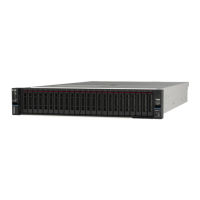1. DIMM configurations that support Sub NUMA Clustering (SNC), which can be enabled via UEFI. SNC is
not supported if DIMM population does not follow the sequence indicated by the table above.
2. DIMM configurations that support Software Guard Extensions (SGX). See
“Enable Software Guard
Extensions (SGX)” on page 437
to enable this feature.
3. Rank mixing is supported between single-rank and dual-rank RDIMMs, or between quad-rank and octal-
rank 3DS RDIMMs when there are 16 DIMMs populated for each processor. See
“Independent mode
with mixing rank” on page 60
for more information on the installation sequence when installing memory
modules with different ranks.
Independent mode with mixing rank
Follow the memory module installation sequence in this section when installing memory modules with
different ranks in independent mode.
DIMM slot installation sequence for one processor
When installing DIMMs with different ranks with only one processor (processor 1) installed, follow the
sequence below and install higher rank DIMMs first; then, install the lower rank DIMMs into the remaining
slots.
Table 30. DIMM slot installation sequence for one processor
Processor 1
DIMM slot 16 15 14 13 12 11 10 9 8 7 6 5 4 3 2 1
Sequence
8 16 7 15 4 12 3 11 9 1 10 2 13 5 14 6
DIMM slot installation sequence for two processors
When installing DIMMs with different ranks with two processors (processor 1 and processor 2) installed,
follow the sequence below and install higher rank DIMMs first; then, install the lower rank DIMMs into the
remaining slots.
Table 31. DIMM slot installation sequence for two processors
Processor 1
DIMM slot 16 15 14 13 12 11 10 9 8 7 6 5 4 3 2 1
Sequence
15 31 13 29 7 23 5 21 17 1 19 3 25 9 27 11
Processor 2
DIMM slot 32 31 30 29 28 27 26 25 24 23 22 21 20 19 18 17
Sequence
16 32 14 30 8 24 6 22 18 2 20 4 26 10 28 12
Mirroring mode installation order
Mirroring mode provides full memory redundancy while reducing the total system memory capacity in half.
Memory channels are grouped in pairs with each channel receiving the same data. If a failure occurs, the
memory controller switches from the DIMMs on the primary channel to the DIMMs on the backup channel.
The DIMM installation order for memory mirroring varies based on the number of processors and DIMMs
installed in the server.
In mirroring mode, each memory module in a pair must be identical in size and architecture. The channels are
grouped in pairs with each channel receiving the same data. One channel is used as a backup of the other,
which provides redundancy.
Follow the rules below when installing memory modules in mirroring mode:
60
ThinkSystem SR630 V3 User Guide

